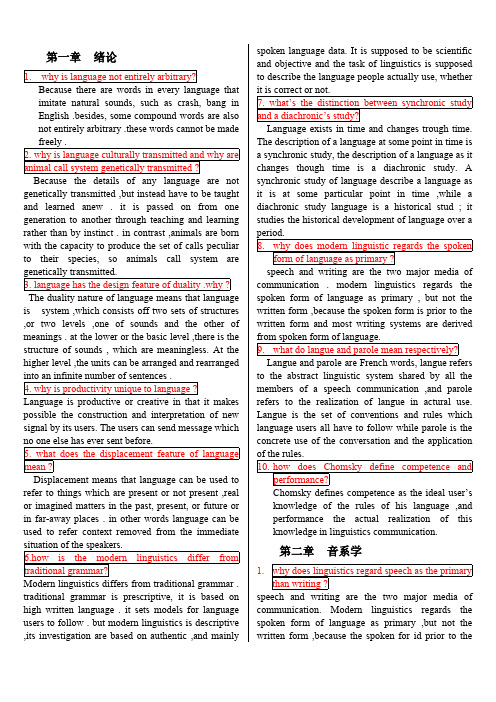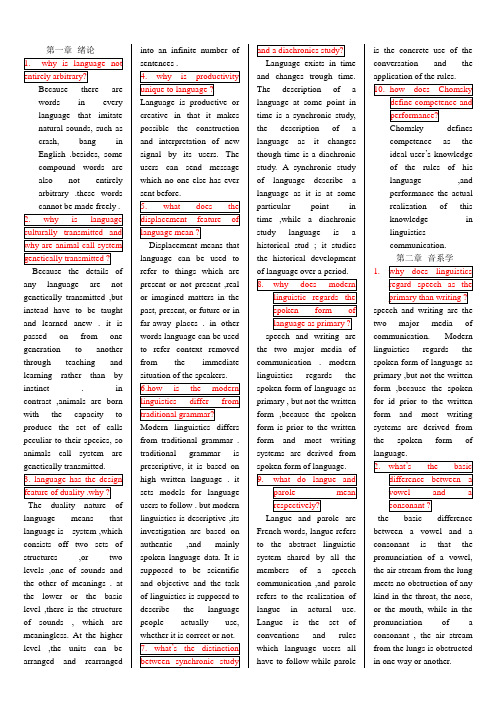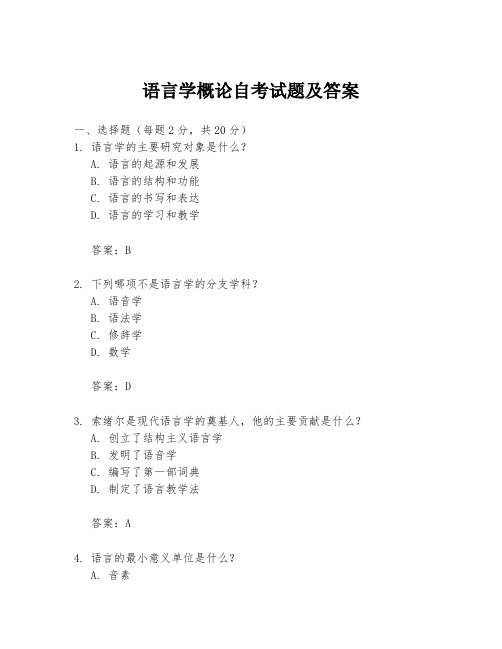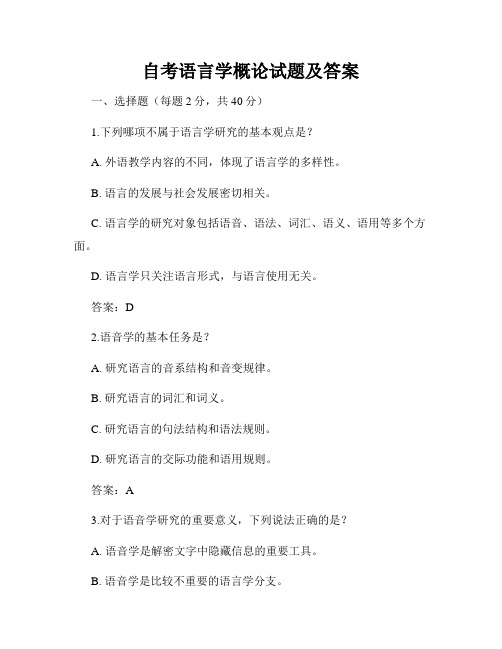自考语言学---简答题
语言学自考纲要试题及答案

语言学自考纲要试题及答案一、选择题(每题2分,共20分)1. 语言学的主要研究对象是什么?A. 文学作品B. 语言行为C. 语言结构D. 语言教学答案:C2. 下列哪项不是语言学的分支学科?A. 社会语言学B. 神经语言学C. 文化研究D. 心理语言学答案:C3. 索绪尔将语言符号分为哪两个部分?A. 语义和语法B. 语音和语义C. 符号和象征D. 能指和所指答案:D4. 语音学中的“最小对立对”是指什么?A. 发音相似的词B. 发音不同的音节C. 只有一处发音不同的词对D. 音节数量不同的词答案:C5. 哪种语言现象说明了语言的任意性?A. 同义词B. 同音词C. 外来词D. 拟声词答案:B6. 转换生成语法是由哪位语言学家提出的?A. 索绪尔B. 乔姆斯基C. 布隆菲尔德D. 萨丕尔答案:B7. 在语言的词汇-语法连续体中,词汇通常位于哪个位置?A. 左端B. 右端C. 中间D. 两端都有可能答案:A8. 语言的同化现象通常发生在什么情况下?A. 语言接触B. 语言孤立C. 语言标准化D. 语言简化答案:A9. 下列哪项不是语用学的研究内容?A. 语境B. 言语行为C. 语义特征D. 隐喻答案:C10. 哪种语言现象可以体现语言的创造性?A. 套话B. 习语C. 新词创造D. 同音词答案:C二、填空题(每题2分,共20分)11. 语言学中的“_______”是指语言符号的任意性,即符号的形式与其指代的对象之间没有必然的联系。
答案:任意性原则12. 社会语言学研究的是语言与_______之间的关系。
答案:社会13. 在语言学中,“_______”是指语言在不同社会群体中的变体。
答案:方言14. 语言的“_______”是指语言随时间演变的过程。
答案:历时变化15. “_______”是指语言在特定情境下的使用,包括语言的选择、组织和解释。
答案:语用学16. 语音学中的“_______”是指音素的最小区别特征。
英语自考当代语言学简答题

2. why is language culturally transmitted and why are animal call system genetically transmitted ?
Because the details of any language are not genetically transmitted ,but instead have to be taught and learned anew . it is passed on from one generation to another through by instinct . in contrast ,animals are born with the capacity to produce the set of calls peculiar to their species, so animals call system are genetically transmitted. 3. language has the design feature of duality .why ?
语言学简答题问答题答案

"语言学概论"名词解释历史语言学:主要用历史的方法研究*种语言的短期的和长期的变化规律,如汉语史、英语史。
共时语言学:研究语言在*一时期的相对静止的情况,如现代汉语。
普通语言学:研究对象是人类语言,着重从理论上探讨语言的共同特点和一般规律,也叫一般语言学。
隐性意义:指隐藏在显性意义后面的各种语法关系,通常表现为施事与动作,动作与受事的关系等。
隐性形式:从微观角度看,句法构造的外部形式具有层次性。
这种层次性不能从外表一眼看出来,需要我们从小到大或从大到小地分析。
显性形式:从宏观上看,句法构造外部形式是线条性,我们把它叫显性形式。
语言学:是研究语言的科学。
语言学家研究的只是经过语言学家主观概括和不同程度上理想化和简单化了的语言。
符号:指的是根据社会的约定俗成使用*种特定的物质实体来表示*种特定的意义而形成的这种实体和意义的结合体。
"符号〞必然包括有任何情况下永远不可分割的两个方面,一个方面是物质的实体,另一个方面是约定俗成的意义。
"能指〞:是索绪尔给语言符号的物质实体创制的一个专门的术语。
也就是能够指称*种意义的成分。
"所指〞:是索绪尔给符号所指的意义容创制的一个专门术语,也就是"能指成分〞,即特定的物质实体,所指的意义容。
语音:虽是一种声音,但又与一般的声音有着本质的区别。
它是由人的发音器官发出的,负载着一定的意义,并作为语言符号系统载体的声音。
音素:是从音质角度划分出来的最小语音单位。
根据音质的不同,对一串语音不断加以切分,直到不能切分为止,这样得到的语音就是"音素〞。
标写语音的书面符号叫做"音标〞。
"音位〞:就是从社会功能的角度划分出来的语音单位,它是特定语言或方言中具有区别意义作用的最小的语音单位。
"音质音位〞和"非音质音位〞:音位从构成材料上看,可以分为音质音位和非音质音位。
以音素为材料,通过音质的差异来起辨义作用的音位叫"音质音位〞。
英语自考现代语言学简答题

第一章 绪论Because there are words in every language that imitate natural sounds, such as crash, bang in English .besides, some compound words are also not entirely arbitrary .these words cannot be made freely .Because the details of any language are not genetically transmitted ,but instead have to be taught and learned anew . it is passed on from one generation to another through teachingand learning rather than by instinct . in contrast ,animals are born with the capacity to produce the set of calls peculiar to their species, so animals call system are genetically transmitted. The duality nature of language means that language is system ,which consists off two sets of structures ,or two levels ,one of sounds and the other of meanings . at the lower or thebasic level ,there is the structure of sounds , which are meaningless. At the higherlevel ,the units can be arranged and rearranged into an infinite number of sentences .Language is productive or creative in that it makes possible the construction and interpretationof new signal by its users. The users can send message which no one else has ever sent before. Displacement means that language can be used to refer to things which are present or not present ,real or imagined matters in the past, present, or future or in far-awayplaces . in other words language can be used to refer context removed from the immediate situation of the speakers. Modern linguistics differs from traditional grammar . traditional grammar is prescriptive, it is based on high written language . it sets models for language users to follow . but modern linguistics is descriptive ,its investigation are based on authentic ,and mainly spoken language data. It is supposed to be scientific andobjective and the task of linguistics is supposed to describe the language people actually use, whether it is correct or not. Language exists in time and changes trough time. The description of a language at some point in time is a synchronic study, the description of a language as it changes though time is a diachronic study. A synchronic study of language describe a language as it is at some particular point in time ,while a diachronic study language is a historical stud ; it studies the historical development of language over a period.speech and writing are the two major media of communication . modern linguistics regards the spoken form of language as primary , but not the written form ,because thespoken form is prior to the written form and most writing systems are derived from spoken form of language. Langue and parole are French words, langue refers to the abstract linguistic system shared by all the members of a speech communication ,and parole refers to the realization of langue in actural use. Langue is the set ofconventions and rules which language users all have to follow while parole is the concrete use of the conversation and the application of the rules. Chomsky defines competence as the ideal user ’s knowledge of the rules of his language,and performance the actual realization of this knowledge in linguisticscommunication. 第二章 音系学1. speech and writing are the two major media of communication. Modern linguistics regards the spoken form of language as primary ,but not the written form ,because the spoken for id prior to the written form and most writing systems are derived from the spoken form of language.the basic difference between a vowel and a consonant is that the pronunciation of a vowel,the air stream from the lung meets no obstruction of any kind in the throat, the nose, or the mouth, while in the pronunciation of a consonant , the air stream from the lungs is obstructed in one way or another.Which allophone is to be used is determined by the phonetic context in which it occurs. But the choice of an allophone is not random or haphazard in most cases; it is rule-governed . one of the tasks of the phonologist is to find out these rules.The phonemic features that occur above the level of the segments are called suprasegmental phonemes; these are the phonological properties of such units as the syllable , the word ,and the sentence. The main suprasegmental featuresinclude stress, tone, and intonation.第三章 形态学Morphology is divided into sub-branches : inflectional morphology and lexical or derivational morphology. Free morphemes are themorphemes which are independent units of meaning and can be used freely all by themselves or in combination with other morphemes .bound morphemes are the morphemes which cannot be used independently but have to be combinedwith other morphemes, either free or bound ,to form a word.derivational affixes are added to an exciting form to create a word . prefixes occur at the beginning of a word and. Prefixes modify the meaning of he stem .suffixes are added to the end of the stems ;they modifythe meaning of the original word and in many cases change its part of speech.Syntactically, the part of speech of the compound is generally determined by the part of speech o the second element, e.g. icy-cold adj. head —strong adv. Greenhouse n. but there are many exception ,especially with hose compounds ending with a verb or an adverb or a preposition . for example,follow up , crackdown ,kickoff are allnouns instead of adverbs.and toothpick, snowfall,and facelift arenoun instead of verbs.semantically, the meaning of a compound is often idiomatic, not always being the sum total of the meaning of its components. For example ,a greenhouse is not a house that is green .in order to find out the meaning of a compound, one sometimes hasto consult the dictionary instead of doing some guess work.第四章 句法学 As a major component of grammar, syntax consists of a set o abstract rules that allow words to be combined with other words to form grammatical sentences. A sentences is considered grammatical when it is in agreement with thegrammatical knowledge in the mind of native speakers. Universally found in the grammars of all human language ,syntactic rules comprise the system of internalized linguistic knowledge of a language speaker known as linguistic competence.Linguistics is generally defined as the scientific study of language. The word language in this definition implies that linguistics studies not any particular language ,but investigate or examine. And the word scientific refers to the way in which language is studied.Chomsky thinks that linguistics should study the ideal speaker ’s competence, but not his performance. For any natural language ,a set of syntactic rules are capable of yielding an endless number of sentences in that language .that is ,the syntactic rules of any language are finite in number, and yet there is no limit to the number of sentences native speakers of that language are able to produce and comprehend.Traditionally, there are three major types of sentences. They are simple sentence,coordinate sentence,and complex sentences.When a sentence is uttered or written down ,the words of the sentences are produced one after another in a sequence. Meanwhile,they are heard or read as arranged one after another in a sequence.therfore, the structure of a sentence is linear.major lexical categories are open categories in the sense that new words are constantly added. Minor lexical categories are closed categories becausethe number of lexical items in this categories is fixed and no new members are allowed for.The combinational pattern in a linear formula may be called a phrase structural rule. Syntactic movement is governed by transformational rules. The operation of the transformational rules may chang the syntactic representation of a sentence.parameters are syntactic options of UG that allow general principles to operate in one way or another and contribute to significant linguistics variation between and among natural language. Another parameter, the one that involves word order, concerns the directionality of case assignment ,i.e the directionality parameter. This parameter offers a neat and consist account forthe typological difference in the word order within the VP category between English and Japanese第五章 语义学Contextualism is based on the presumption that one can derive meaning from or reduce meaning to observable contexts. Two kinds of contest are recognized :the situational context and the Linguistic context.Obviously, linguistic forms with the same sense may have different references in different situation. For example, in the following exchange, the two speakers are surely talking about two different references, i.e. two different gogs.But because of their differentorigin ,there are often subtle differences between thesesynonyms .synonyms that are mutually substitutable under all circumstances are called complete synonyms . however, complete synonyms are rare.Dialectal synonyms which are used in different regional dialects .stylistic synonyms which differ in style. Synonyms hat siffer in their emotive or evaluation meaning collocational synonymssemantically different synonyms.A polysemic word i.e. a word with several meanings, is the result of the evolution of the primary meaning o the word ,the various meaning of the word are related to some degree ,as is discussed in the previous section.There is one advantage of componential analysis . by specifying the semantic features of certain words I will be possible to show how these words are related in meaning.there are three kinds. they are gradable antonyms,complementary antonyms and relational opposites. 第六章语用学Without this shared knowledge, linguistics communication would be impossible, and without considering this knowledge , linguistics communication cannot satisfactorily accounted for in apragmatic sense.If we regard a sentence as what people actually utter in the course of communication , it becomes an utterance ,and it should be considered in the situation in which it is actually uttered.Therefore ,while themeaning of a sentence is abstract ,and decontextualized, the meaning of an utterance is concrete ,and context-dependent. the act theory is the act of uttering words, phrases ,clauses. It is the ac of conveying literal meaning by meaning of syntax, lexicon and phonology.第七章 历史语言学Researches in historical linguistics shed light on prehistoric development in the evolution of language and the connections of earlier and later variants ofthe same language ,andprovide valuable insights into the kinship patterns of difference languages.it is generally accepted that the history of the English language is divided into the period of old English ,middle English and modern English.3.The most vigorous and no-going change in the historical development of a language is the change in its vocabulary.They are the Indo-European Family, The Sino-Tibetan Family, the Austronesian Family ,and the Afroasiatic Family.Grimm ’s major contribution to historical is his explanation of the relationships among cognates in terms of a sound shift, the systematic modification of a series of phonemes.Language do not change without reasons . a linguistics change is caused either by the inherent nature of language , or by external contacts of speakers of one language with the speakers of the other language.第八章 社会语言学Sociolinguistics is the study of language in social contexts. Sociolinguistics are also concern with the influence of extralinguistic factors on language use, such as age, gender, profession, and social statue.Sociolinguistics is the study of language in social contexts . in view of language as a primary means of communication among individual speakers of a society , sociolinguists are concerned with he social significance of language variation and languageuse indifferent speech communities including regional ,ethnic and social groups . sociolinguists are also concerned with the influence of extralinguistic factors on language use, such as age, gender,profession ,and social statue.The important characteristic of a speech community is that the members of the group must ,in some reasonable way, interact linguistically with other members of the community .they may share closely related language varieties, as wellas attitudes towards linguistic norms.they are regional dialects ,sociolects or social dialects ,and registers.第九章 心理语言学psycholinguistics is the study of language in relation to the mind. As the term suggests, psycholinguistics is viewed as the intersection of psychology and linguistics, drawing equally upon the language we acquire, produce and comprehend.By mean of dichotic listening tests, we can analyze the characteristic of incoming stimuli processed by the individual hemispheres.3. I has been proposed that the brain activity involved in hearing , understanding andthen saying a word would follow a definite pattern. 4.A safe conclusion from Genie ’s case for the moment is that the labguage faculty of an average human degenerates after the critical period and consequently ,most linguistic skills cannot develop.The most provocative position to date on the relationship between language and thought has been what is known as the Sapir-Whorf hypothesis.第十章 语言习得the study of language acquisition enables linguistics ,psychologists and applied linguists to better understand the nature of human language and the developmental processes oflanguage acquisition.The biological, ornativist, view of language acquisition means that human are equipped with the neural prerequisites for language and language use. 3.In principle ,no human brain can store all the words and expressions of a language . what happens is that when processing the language the hear ,children construct the grammar and make sense of the expression according to the grammar . when producing utterances, they follow the internalizedgrammatical rules.Starting from the prelinguistic cooing and babbling stage ,children move through the one-word ,two-word and multiword stage ,gradually acquiringphonology ,morphology, syntax, vocabulary, semantics, and discourse skills of the adult language system as they grow.Although SLA is not entirely different from FLA.some problems experienced in L2development by teenage or adult learners simply donot exist in children ’s L1. According toKrashen ,acquisition refersto the gradual and subconscious development of ability in the first language by using it naturally in daily communicativesituation .learning ,however,is defined as a conscous process of accumulating knowledge of a second language usually obtained in school settings.It has been claimed that the optimum age for SLA is early teenage.。
自考语言学概论复习题

自考语言学概论复习题一、选择题1. 语言学是研究语言的科学,它主要研究语言的哪些方面?A. 语音和语法B. 词汇和语义C. 语音、语法、词汇、语义D. 语音、语法、词汇、语义、语用2. 下列哪个选项不属于语言学的分支学科?A. 语音学B. 语法学C. 修辞学D. 语用学3. 语言的最小意义单位是什么?A. 音节B. 词C. 语素D. 句4. 语言学中的“同音异义词”指的是什么?A. 两个词发音相同,意义不同B. 两个词意义相同,发音不同C. 两个词发音相同,意义相同D. 两个词意义不同,发音不同5. 语言的变异现象主要体现在哪些方面?A. 语音、语法、词汇B. 语法、词汇、语义C. 语音、词汇、语义D. 语音、语法、语用二、填空题6. 语言学的四大分支包括语音学、语法学、_______、_______。
7. 语言的最小意义单位是_______,它能够独立地表达意义。
8. 语言的_______是指语言在不同地区、不同社会群体中的不同表现形式。
9. 语言的功能包括表达思想、交流信息、_______、_______等。
10. 语言学研究的目的是揭示语言的_______,促进语言的学习和使用。
三、简答题11. 简述语言学研究的主要目的和意义。
12. 描述语言的语音系统是如何构成的。
13. 解释什么是语法规则,并举例说明。
14. 阐述词汇和语义之间的关系。
15. 讨论语言变异现象对语言发展的影响。
四、论述题16. 论述语言学在现代科技中的应用及其重要性。
17. 分析语言与文化之间的关系,并举例说明。
18. 探讨语言规划和语言政策对社会发展的影响。
19. 论述语言习得理论对第二语言教学的启示。
20. 讨论语言的交际功能及其在日常生活中的应用。
五、案例分析题21. 请分析下列对话中的语言现象,并解释其语言学意义。
- 对话一:A: “你今天看起来很高兴。
” B: “是的,我通过了考试。
”- 对话二:A: “这本书太难了,我看不懂。
语言学概论自考试题及答案

语言学概论自考试题及答案一、选择题(每题2分,共20分)1. 语言学的主要研究对象是什么?A. 语言的起源和发展B. 语言的结构和功能C. 语言的书写和表达D. 语言的学习和教学答案:B2. 下列哪项不是语言学的分支学科?A. 语音学B. 语法学C. 修辞学D. 数学答案:D3. 索绪尔是现代语言学的奠基人,他的主要贡献是什么?A. 创立了结构主义语言学B. 发明了语音学C. 编写了第一部词典D. 制定了语言教学法答案:A4. 语言的最小意义单位是什么?A. 音素B. 语素C. 词汇D. 句子答案:B5. 什么是语言的双重性质?A. 口头和书面B. 自然和人工C. 动态和静态D. 社会和个体答案:C6. 下列哪项是语言的任意性特征?A. 语言的规则性B. 语言的创造性C. 语言的声音和意义之间的关系是任意的D. 语言的普遍性答案:C7. 转换生成语法是由哪位语言学家提出的?A. 索绪尔B. 乔姆斯基C. 布隆菲尔德D. 萨丕尔答案:B8. 语言的同质性指的是什么?A. 语言的统一性B. 语言的多样性C. 语言的复杂性D. 语言的简单性答案:A9. 语言学中的“深层结构”和“表层结构”是由谁提出的?A. 索绪尔B. 乔姆斯基C. 布隆菲尔德D. 萨丕尔答案:B10. 下列哪项不是语言的功能?A. 信息传递B. 情感表达C. 艺术创作D. 物理治疗答案:D二、填空题(每题2分,共20分)11. 语言学中的“能指”指的是________,而“所指”指的是________。
答案:声音;概念12. 语音学中的“元音”和“辅音”是根据________来区分的。
答案:声道是否受阻碍13. 语法学研究的是语言的________和________。
答案:规则;结构14. 社会语言学关注的是语言与________之间的关系。
答案:社会因素15. 语用学研究的是语境中语言的________和________。
答案:使用;理解16. 语言的“同步研究”关注的是语言在某一特定时期的________,而“历时研究”则关注语言的________。
语言学简答题

一结合语言学理论试将你所使用的方言或民族语言在语音,词汇,语法等方面与普通话作比较。
答:方言与普通话的区别1、概念不同:普通话是以北京语音为标准音,以北方话(官话)为基础方言,以典范的现代白话文著作为语法规范的现代标准汉语。
中国人口中所称“方言”是一个政治学概念,实为“地方语言”,又称“白话”,指的是区别于标准语的某一地区的语言,这种叫法不考虑语言间的亲属关系。
2、语法不同:普通话中,动词后面带双宾语时,指人的宾语在前,指物的宾语在后面。
如:“给我一本书。
”一些方言有时双宾语的语序与普通话相反。
如:“给本书我。
”云南方言属北方方言的西南方言区(不包括少数民族的民族语言)。
一直以来云南少数民族众多,语言混杂,给经济交往和文化交流颇多不便,汉唐以后汉文化逐渐传入,随着与中原地区的交往日渐深入(包括通商、通婚、和文化交流),汉语逐渐传入云南,特别是元明清时期中国现在的版图基本形成,为了加强对边疆地区的控制,大量的人口被迁往边疆地区,他们带来了先进的文化和生产技术促进了边疆地区的开发,同时在与当地少数民族通婚,交流的过程中互相影响形成了云南发言。
这也是少数民族被逐渐汉化的过程。
汉语的普遍使用是形成云南方言的先决条件。
云南方言以汉语为主体,经过了经千年的演变,汉语和云南方言在语音、词汇、语法方面有许多差异下面我们就从语音,词汇和语法方面来一一说明。
(对云南汉语方言的形成起了决定性的作用。
在经过千年的时间演化之后,云南方言与如今的普通话有什么区别呢?现从语音、词汇、语法方面作举例说明) 1. 语音(1)入声受自然环境和少数民族语言发音方式的影响,云南方言云南话用以结尾的字几乎全是入声,蜀黔虽然也大部分类似使用,但远非滇方言普遍。
通观三地方言,这样的例子不胜枚举。
如“变化”一次,在云南方言中,“化”字的发音在普通话“化”和“换”之间。
但云南方言的入声有些弱化,不如粤语明显。
而普通话中,入声早已消失。
(2)前后鼻音不分云南大多数地区前后鼻音不能分清。
自考语言学概论试题及答案

自考语言学概论试题及答案一、选择题(每题2分,共40分)1.下列哪项不属于语言学研究的基本观点是?A. 外语教学内容的不同,体现了语言学的多样性。
B. 语言的发展与社会发展密切相关。
C. 语言学的研究对象包括语音、语法、词汇、语义、语用等多个方面。
D. 语言学只关注语言形式,与语言使用无关。
答案:D2.语音学的基本任务是?A. 研究语言的音系结构和音变规律。
B. 研究语言的词汇和词义。
C. 研究语言的句法结构和语法规则。
D. 研究语言的交际功能和语用规则。
答案:A3.对于语音学研究的重要意义,下列说法正确的是?A. 语音学是解密文字中隐藏信息的重要工具。
B. 语音学是比较不重要的语言学分支。
C. 语音学与语义学和语用学的关系并不密切。
D. 语音学只研究母语的发音,与第二语言无关。
答案:A4.下列哪项不属于词法学的研究内容?A. 词法单位的构成。
B. 词汇的分类和词义变化。
C. 词法的语用功能。
D. 词法的音韵规律。
答案:D5.语法学研究的是?A. 语言的音韵规则和语音结构。
B. 语言的词汇和词义。
C. 语言的句法规则和句子结构。
D. 语言的交际功能和语用规则。
答案:C二、简答题(每题5分,共30分)1.简述语言学的定义和研究对象。
答案:语言学是研究语言的一门学科,它研究语言的构成、发展、功能和使用规则等方面的问题。
语言学的研究对象包括语音、语法、词汇、语义和语用等多个方面。
通过对语言的结构和功能进行研究,语言学旨在了解语言的本质及其在人类社会中的作用。
2.简述语音学和语法学的关系。
答案:语音学和语法学都是语言学的分支学科,它们之间有着密切的关系。
语音学研究语言的音系结构和音变规律,即语言的发音和语音系统。
而语法学研究语言的句法结构和语法规则,即语言的句子结构和组织规律。
语音学和语法学在研究对象和方法上有所不同,但都关注语言的形式和结构,互相补充和支持,共同构成了对语言的全面研究。
3.语用学研究的是什么内容,它在语言学研究中的作用是什么?答案:语用学研究语言的交际功能和语用规则,即语言的使用方式和交际目的。
- 1、下载文档前请自行甄别文档内容的完整性,平台不提供额外的编辑、内容补充、找答案等附加服务。
- 2、"仅部分预览"的文档,不可在线预览部分如存在完整性等问题,可反馈申请退款(可完整预览的文档不适用该条件!)。
- 3、如文档侵犯您的权益,请联系客服反馈,我们会尽快为您处理(人工客服工作时间:9:00-18:30)。
【题型:简答】【100分】
[1]
Why is language not entirely arbitrary?
得分:100分
答:imitating natural sounds|compound words|not entirely arbitrary
【题型:简答】【100分】
[1]
Why does modern linguistics regard the spoken form of language as primary?
得分:100分
答:spoken and written|spoken is prior to written|written is derived from spoken
[1]
Why do you think the sound produced by human is the language in a sense?
得分:100分
答:arbitrariness|productivity|duality|displacement| cultural transmission
[1]
What is the major difference between Saussure's distinction between langue and parole and Chomsky's distinction between compe 得分:100分
答:langue is social product|competence as a property of the mind |sociological point of view |psychological
[1]
Exemplify the relationship between phone, phoneme and allophone.
得分:100分
答: A phone is phoentic unit or segment| phones may or may not distinguish meaning| A phoneme is not any part representented or realized by a certain phone in a certain phonetic context|The phones representing a ph allophones
【题型:简答】【100分】
[1]
What are the major periods in the history of English and how is it classified?
得分:100分
答:old English|middle English| modern English|conventional and arbitrary
[1]
What is the difference between a pidgin and Creole?
得分:100分
答:variety of language|native speakers|medium of communication|practical purpose|native language|some speec 【题型:简答】【100分】
[1]
What are the two major functions of language?
得分:100分
答:interpersonal communication|intrapersonal coummunication
【题型:简答】【100分】
[1]
How are sentence meaning and utterance meaning related, and how do they differ?
得分:100分
答:realization|context|concrete
【题型:简答】【100分】
[1]
Briefly discuss the individual factors which affect the acquisition of a second language.得分:100分
答:age|motivation|acculturation|personality。
